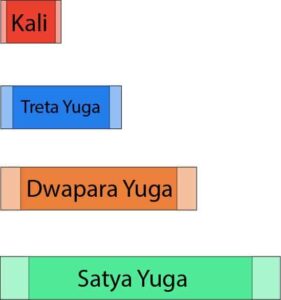
Satya yuga is the golden age, the first of the four yugas. To understand what is Satya yuga, we will discuss its duration, the different Vishnu avatars that appear in it, as well as other important symptoms. It is known as a time when all of humanity coexists in a spirit of goodwill and complete harmony. A yuga is a cosmic age according to the Vedic system of measuring universal time. The four yugas are Satya Yuga, Treta Yuga, Dvapara Yuga, and Kali Yuga, and together they comprise one full yuga cycle. One thousand Yuga cycles is equal to a day of Brahma, also known as a kalpa.
The Duration of Satya Yuga
In Vedic cosmology, various regions within the universe experience time differently due to the phenomenon of time dilation. For example, one year in the realm of Svarga is approximately equal to 720 solar years on our planet Earth.
For this reason, the Vedas give two different measurements for the duration of Satya Yuga. In years of the devas, Satya Yuga lasts 4,800 years, and on Earth, it lasts 3.456 million years. The duration of Satya Yuga is described in the Vayu Purana as follows:
Four thousand years constitute the Kṛta [Satya] Yuga, which is also called the Prakriyāpāda. Four hundred years constitute the Saṃdhyā and four hundred years the Saṃdhyāṃśa, which are transition periods at the beginning and end of the Yuga, respectively. (Vāyu Purāṇa 1.32.55-56).
The most recent Satya Yuga ended approximately 4.33 million years ago.
| Time Unit | Solar Years |
|---|---|
| Kali Yuga | 0.864 million years |
| Treta Yuga | 1.728 million years |
| Dwapara Yuga | 2.592 million years |
| Satya Yuga | 3.456 million years |

General Overview
In Satya Yuga, human beings were adept in meditation and possessed unbelievable strength and longevity. The Vedic texts state that humans during Satya Yuga, or the Golden Age, lived for up to 100,000 years. There was no disparity among cultures. Everyone enjoyed worldly comforts and lived in perfect harmony with the natural environment. There was no war, famine, or conflict among the human race. It was a time of complete peace on Earth. However, as time progressed, people became less inclined toward spiritual practices and wished to augment their material comforts beyond their needs. A spirit of competition arose among men and as a result the system of varnasrama, or class-based society, was introduced. This ushered in the Dvapara Yuga, or Silver Age.
LEARN MORE: The Puranas provide an advanced understanding of our universe, including descriptions of life on other planets. Check out our guide to Vedic Cosmology.
What Comes Next?
After Satya Yuga is Treta Yuga, the Silver Age. Treta Yuga lasts 3,600 years of the devas, or 2.592 million human years. Check out our article to learn more about Treta Yuga.